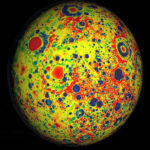The Máni on the Moon Chased by a Walloping Warg

The Moon is a woman in most European-based mythologies. In fact, below is a list of 16 such goddesses, though some are different versions of very similar goddesses, such as Diana and Artemis.
Goddess Diana (Roman mythology)
Goddess Achelois (Greek mythology)
Goddess Arianrhod (Welsh mythology)
Goddess Artemis (Greek mythology)
Goddess Artume (Etruscan mythology)
Goddess Ataegina (Lusitanian mythology)
Goddess Bendis (Thracian mythology)
Goddess Hecate (Greek mythology)
Goddess Ilargi (Basque mythology)
Goddess Kuu (Finnish mythology)
Goddess Losna (Etruscan mythology)
Goddess Luna (Roman mythology)
Goddess Mano (Sami mythology)
Goddess Phoebe (Greek mythology)
Goddess Selene (Greek mythology)
Goddess Trivia (Roman mythology)
This does not count Christianity’s Virgin Mary, who is not a goddess but who is often associated with the Moon in European arts and literature. In contrast, there are only four male versions of the moon in European mythology:
God Tylze (Mari mythology)
God Elatha (Irish mythology)
God Hors (Slavic mythology)
God Máni (Norse mythology)
Máni on the Moon
Because of the research I conducted while writing The Tollkeeper, I focused on the Norse version of the moon deity, Máni. He is, however, less of a deity than mythical figure. Here’s how the Prose Edda describes the origins of the Máni.
Mundilfare hight the man who had two children. They were so fair and beautiful that he called his son Moon [that is Máni] , and his daughter, whom he gave in marriage to a man by name Glener, he called Sun [that is, Sól]. But the gods became wroth at this arrogance, took both the brother and the sister, set them up in heaven, and made Sun drive the horses that draw the car of the sun, which the gods had made to light up the world from sparks that flew out of Muspelheim…. Moon guides the course of the moon, and rules its waxing and waning.

“Far away and long ago” (1920) by Willy Pogany
Both Máni and Sól are chased around the heavens by two huge wolves, or wargs, known as Hati Hróðvitnisson and Sköll, respectively. The wargs are said to be the sons of Fenrir, the giant wolf destined to kill the king of Norse gods, Odin.
Chapter Two of The Tollkeeper begins with the following quote:
“In the forest dwell troll-women, who are known as Ironwood-Women. The old witch gives birth to many giant sons.”
This is reference to the mother of Hati Hróðvitnisson, who is a giantess or “troll-woman” as well as a witch. She lives in the forest of known as Járnviðr (aka, “Ironwood”) and fosters giant sons, all of whom are apparently giant wolves.
A Dude Name Máni
Moon is also followed by two children, Hjúki and Bil, who were originally taken up from the earth by Máni.
Given the history of moon goddesses in Europe, it’s understandable that so many poems in the Western tradition allude to it as an alluring or virginal woman. In fact, it originally struck me as interesting and somehow incongruous that the moon is male in Norse mythology. As a satire of, as well as tribute to, all the verse that alludes to the moon as a woman, I wrote the following poem:
The skalds said the moon is a dude named Máni,
Who’s staying one step ahead of the wolves at his door,
A divorced dad who drinks and pays plenty of alimony
Plus support for two spoiled kids he loves to the core.
He sure as hell is no shrouded pale virgin of mystery
As the sad sack poets of romance tell in their dainty lore.
Hell, Máni’s just a longshoreman with aching knees
Who yanks at the tides with hooks, ropes, cables and more.
A couple of days a month, he’s too hungover to even see
So he calls in sick, draws the drapes, and soothes his sore
Head with frozen steaks, or chicken wings, or bags of peas.
Yeah, he may seem like a loser and a broody boor,
But, truth be told, Máni is so freaking steady and dependable that we
Can set our watches by his seasons of dejection, renewal and joy.
He’s not so different from other guys or gals, or you or me,
Maybe not so bright as sister Sól but Máni reflects our humanity.
Image: NASA/JPL-Caltech/MIT/GSFC - GRAIL's Gravity Map of the Moon
The post The Máni on the Moon Chased by a Walloping Warg appeared first on The Tollkeeper.



